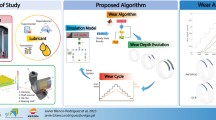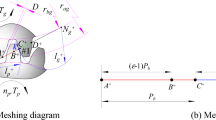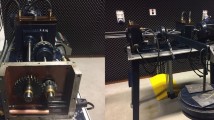Abstract
This study proposes a computational approach to determine the operating condition, under which the rolling contact fatigue (RCF) crack nucleation of the sun-planet mesh of a tractor final drive is accelerated. Although the experimental RCF time period can be reduced by increasing the rotational velocity, the resultant increase in the film thickness promotes the lubrication condition and thus lengthens the fatigue life. To counteract this fatigue performance variation, it is proposed to increase the lubricant temperature at the same time. In the process, the lubricant viscosity decreases and offsets lubrication film thickness increase introduced by the rotational velocity increase. A physics-based gear contact fatigue model that includes the descriptions of the mixed elastohydrodynamic lubrication, the multi-axial stresses and the multi-axial fatigue is used to quantify the impacts of the lubricant temperature and the rotational velocity on the crack formation, allowing the fine tune of the temperature and velocity parameters.











Similar content being viewed by others
References
Li S, Kahraman A (2011) A fatigue model for contacts under mixed elastohydrodynamic lubrication condition. Int J Fatigue 33(3):427–436
Li S, Kahraman A, Klein M (2012) A fatigue model for spur gear contacts operating under mixed elastohydrodynamic lubrication conditions. ASME J Mech Des 134(4):041007
Li S, Kahraman A (2013) Micro-pitting fatigue lives of lubricated point contacts: experiments and model validation. Int J Fatigue 48:9–18
Li S, Kahraman A (2013) A physics-based model to predict micro-pitting lives of lubricated point contacts. Int J Fatigue 47:205–215
Li S, Kahraman A (2014) A micro-pitting model for spur gear contacts. Int J Fatigue 59:224–233
Li S (2015) An investigation on the influence of misalignment on micro-pitting of a spur gear pair. Tribol Lett 60(3):35
Evans HP, Snidle RW, Sharif KJ, Shaw BA, Zhang J (2013) Analysis of micro-elastohydrodynamic lubrication and prediction of surface fatigue damage in micropitting tests on helical gears. ASME J Tribol 135:011501
Bower A (1988) The influence of crack face friction and trapped fluid on surface initiated rolling contact fatigue cracks. ASME J Tribol 110(4):704–711
Rico JEF, Battez H, Cuervo DG (2003) Rolling contact fatigue in lubricated contacts. Tribol Int 36:35–40
Fajdiga G, Glodez S, Kramar J (2007) Pitting formation due to surface and subsurface initiated fatigue crack growth in contacting mechanical elements. Wear 262:1217–1224
Li S, Kahraman A (2009) A mixed EHL model with asymmetric integrated control volume discretization. Tribol Int 42(8):1163–1172
Li S (2015) A thermal tribo-dynamic mechanical power loss model for spur gear pairs. Tribol Int 88:170–178
Ekberg A (2001) Anisotropy and rolling contact fatigue of railway wheels. Int J Fract 23(1):29–43
Hoffmann G, Hanejko FG, Slattery RH (2006) Crack initiation and propagation in RCF, a new approach to understanding pitting failure of highly loaded gears. SAE World Congress, Detroit
Webster MN, Norbart CJJ (1995) An experimental investigation of micropitting using a roller disk machine. Tribol Trans 38(4):883–893
Ariura Y, Ueno T, Nakanishi T (1983) An investigation of surface failure of surface-hardened gears by scanning electron microscopy observations. Wear 87:305–316
Cheng W, Cheng HS (1995) Effect of surface roughness orientation on pitting resistance of lubricated rollers. Tribol Trans 38(2):396–402
Ahlroos T, Ronkainen H, Helle A, Parikka R, Virta J, Varjus S (2009) Twin disc micropitting tests. Tribol Int 42(10):1460–1466
Li S (2015) A computational study on the influence of surface roughness lay directionality on micropitting of lubricated point contacts. ASME J Tribol 137(2):021401
Winter H, Weiss T (1981) Some factors influencing the pitting, micro-pitting (frosted areas) and slow speed wear of surface hardened gears. J Mech Des 103(2):499–505
Oila A, Bull SJ (2005) Assessment of the factors influencing micropitting in rolling/sliding contacts. Wear 258(10):1510–1524
Brechot P, Cardis AB, Murphy WR, Theissen J (2000) Micropitting resistant industrial gear oils with balanced performance. Ind Lubr Tribol 52(3):125–136
Lainé E, Olver AV, Beveridge TA (2008) Effect of lubricants on micropitting and wear. Tribol Int 41(11):1049–1055
Ringsberg JW, Loo-Morrey M, Josefson BL, Kapoor A, Beynon JH (2000) Prediction of fatigue crack initiation for rolling contact fatigue. Int J Fatigue 22(3):205–215
Šraml M, Flašker J, Potrč I (2003) Numerical procedure for predicting the rolling contact fatigue crack initiation. Int J Fatigue 25(7):585–595
Davoli P, Bernasconi A, Carnevali L (2003) Application of multiaxial criteria to contact fatigue assessment of spur gears. In: Proceedings of ASME design engineering technical conferences and computers and information in engineering conference, September 2003, Chicago, Illinois, USA. DETC2003/PTG-48001
Snidle RW, Evans HP (2010) Mixed lubrication and prediction of surface fatigue in gear tooth contacts. In: Proceedings of international conference on gears, Technical University of Munich, October 2010, VDI-Berichte, Dusseldorf, Germany. VDI-Berichte No. 2108
Epstein D, Keer LM, Wang QJ, Cheng HS, Zhu D (2003) Effect of surface topography on contact fatigue in mixed lubrication. Tribol Trans 46(4):506–513
Zhu D, Ren N, Wang QJ (2009) Pitting life prediction based on a 3D line contact mixed EHL analysis and subsurface von Mises stress calculation. J Tribol 131(4):041501
Li S, Kahraman A (2010) A transient mixed elastohydrodynamic lubrication model for spur gear pairs. ASME J Tribol 132(1):011501
Li S, Kahraman A (2010) Prediction of spur gear mechanical power losses using a transient elastohydrodynamic lubrication model. Tribol Trans 53(4):554–563
Wang Y, Hadfield M (1999) Rolling contact fatigue failure modes of lubricated silicon nitride in relation to ring crack defects. Wear 225–229(2):1284–1292
Li S, Kahraman A (2011) Influence of dynamic behavior on elastohydrodynamic lubrication of spur gears. J Eng Tribol 225(8):740–753
Li S, Kahraman A (2011) A spur gear mesh interface damping model based on elastohydrodynamic contact behavior. Int J Powertrains 1(1):4–21
Li S, Kahraman A (2013) A tribo-dynamic model of a spur gear pair. J Sound Vib 332:4963–4978
Li S, Kahraman A, Anderson NE, Wedeven LD (2013) A model to predict scuffing failures of a ball-on-disk contact. Tribol Int 60:233–245
Li S (2013) Influence of surface roughness lay directionality on scuffing failure of lubricated point contacts. ASME J Tribol 135(4):041502
Hu YZ, Zhu D (2000) A full numerical solution to the mixed lubrication in point contacts. ASME J Tribol 122:1–9
Johnson KL (1985) Contact mechanics. Cambridge University Press, Cambridge
Li S (2014) A boundary element model for near surface contact stresses of rough surfaces. Comput Mech 54(3):833–846
Liu Y, Mahadevan S (2007) A unified multiaxial fatigue damage model for isotropic and anisotropic materials. Int J Fatigue 29:347–359
Kahraman A, Ligata H, Kienzle K, Zini DM (2004) A kinematics and power flow analysis methodology for automatic transmission planetary gear trains. ASME J Mech Des 126:1071–1081
Bair S, Qureshi F (2002) Accurate measurements of pressure-viscosity behavior in lubricants. Tribol Trans 45(3):390–396
LDP, Gear Load Distribution Program (2012) Gear and power transmission research laboratory. The Ohio State University, Columbus
Ferguson S, Johnson J, Gonzales D, Hobbs C, Allen C, Williams S (2015) Analysis of ZDDP content and thermal decomposition in motor oils using NAA and NMR. Phys Procedia 66:439–444
Author information
Authors and Affiliations
Corresponding author
Rights and permissions
About this article
Cite this article
Li, S., Wagner, J.J. Determination of the accelerated RCF operating condition of the sun-planet contact of a tractor final drive using a computational method. Meccanica 52, 431–440 (2017). https://doi.org/10.1007/s11012-016-0401-7
Received:
Accepted:
Published:
Issue Date:
DOI: https://doi.org/10.1007/s11012-016-0401-7




